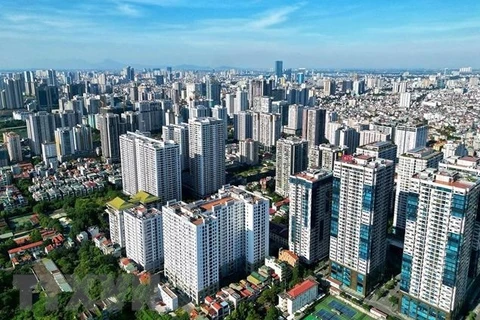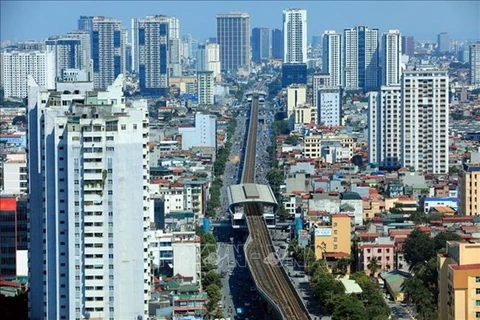Hanoi (VNS/VNA) - Experts have emphasised the pressing need to address the housing challenges faced by migrant workers in industrial parks and export processing zones, where they often live in cramped, small houses in substandard conditions.
Housing solutions for workers has become the utmost priority to ensure the wellbeing of staff and their continued dedication to their jobs, they said.
Luong Tien Dung, a worker from Thanh Hoa province, has been renting a room near Chau Son Industrial Zone in Phu Ly city, Ha Nam province, for five years.
“My wife and I earn an average worker's income of around 15 million VND monthly. We manage to save 3-4 million VND per month, hoping to buy a small apartment so we can settle down," he said.
Another worker, Hoang Thi Lien, from northern Phu Tho province, is currently renting a 20sq.m room in a boarding house in Bach Thuong ward in Phu Ly city near Dong Van Industrial Zone.
The house has a metal roof, making it extremely hot during the summer months.
"At the beginning of this month, the landlord told us about an electricity price hike, leading to an increase in our living expenses," she said.
"When I was single, I took advantage of overtime work to escape the heat by staying at the company where there is air conditioning. But after getting married and having a baby, I spend my time at home with just a regular fan to keep cool.”
Given the high cost of living in the city, Lien said buying a house is not feasible.
“We are considering sending our child back to our grandparents' house in Nghe An province,” she said.
Dung and Lien are among numerous migrant workers who left their hometowns in search of better opportunities in big cities. Despite their efforts, most workers, with their limited financial capacity and the soaring living cost in cities, find it impossible to own a house.
High demand
Vu Minh Tien, Head of the Vietnam General Confederation of Labour (VGCL)’s Institute for Workers and Trade Unions, highlighted the pressing need for affordable houses, especially for migrant workers in industrial parks and export processing zones in Hanoi and Binh Duong province, as well as Dong Nai, Long An and Ha Nam provinces.
The institute conducted surveys in 16 cities and provinces with numerous industrial zones nationwide and found that up to 41% of workers desired affordable and suitable housing near their workplaces to ensure their living conditions. However, this remains extremely challenging due to workers’ low income.
“It is very challenging for migrant workers to buy a house as only a few can afford social housing,” he said.
The survey also showed that about 90% of migrant workers had to rent in cramped, substandard rooms.
Le Van Nghia, head of the Trade Union’s Project Management Board under VGCL, said the union has conducted surveys on the living and housing conditions of workers and found that many of them had to stay in tiny rooms measuring only 10-20sq.m.
These rooms have no toilets or kitchens, and were extremely hot and stuffy on summer days.
In 2017, VGCL proposed a project to build social housing for workers. However, it has encountered obstacles due to Land Law and Housing Law. It has also made proposals to address these difficulties. Currently, there are 35 localities that have allocated land of three to seven hectares to build residential areas for workers.
"If policy obstacles are resolved, the process of project documentation and procedures will take about two-three years, and the construction process can be completed within one year. Currently, Ha Nam province is piloting the construction of 244 apartments for workers," he said.
Tran Tuan Anh, Deputy Head of the Management Board of Hanoi’s Industrial and Export Processing Zones, said the city has nearly 170,000 workers, but in reality, there are only around 22,000 accommodations available for them.
Currently, there are four housing projects for workers in industrial and export processing zones with a total design capacity of about 22,000 housing units. These projects include the pilot project for worker housing in Kim Chung ward in Dong Anh district, which can accommodate about 11,520 workers from Thang Long Industrial Zone. The housing project in Phu Nghĩa Industrial Zone has partly completed with a total floor area of 4,822sq.m, equivalent to 106 apartments for about 800 workers.
The Meiko Company’s housing project has completed two-thirds of its construction and put into use 330 apartments, providing 2,290 housing units. The Young Fast Optoelectronics Co. Ltd’s housing project has completed the construction and put into use 49 apartments to meet the housing needs of experts and workers of the company. These two projects are built by businesses on land allocated to them.
Anh said investors are not interested in building social housing for workers, especially projects with a payback period of 20 to 30 years due to low profitability.
In addition, workers' demand for social housing is diversified. The majority of workers have a demand for rental housing as they tend to return to their hometowns when they retire.
These are issues that policymakers need to carefully consider as the social housing construction must be suitable for the characteristics and lifestyles of workers and close to industrial and export processing zones.
One more problem, he said, is workers’ income. A couple of workers have monthly salaries of 13 million VND, so no one dares to spend 3 million VND renting a house.
Therefore, the priority is to improve the living standards and income of workers while ensuring transparency in the process of building housing for workers, and attract the participation of enterprises, he said./.
Housing solutions for workers has become the utmost priority to ensure the wellbeing of staff and their continued dedication to their jobs, they said.
Luong Tien Dung, a worker from Thanh Hoa province, has been renting a room near Chau Son Industrial Zone in Phu Ly city, Ha Nam province, for five years.
“My wife and I earn an average worker's income of around 15 million VND monthly. We manage to save 3-4 million VND per month, hoping to buy a small apartment so we can settle down," he said.
Another worker, Hoang Thi Lien, from northern Phu Tho province, is currently renting a 20sq.m room in a boarding house in Bach Thuong ward in Phu Ly city near Dong Van Industrial Zone.
The house has a metal roof, making it extremely hot during the summer months.
"At the beginning of this month, the landlord told us about an electricity price hike, leading to an increase in our living expenses," she said.
"When I was single, I took advantage of overtime work to escape the heat by staying at the company where there is air conditioning. But after getting married and having a baby, I spend my time at home with just a regular fan to keep cool.”
Given the high cost of living in the city, Lien said buying a house is not feasible.
“We are considering sending our child back to our grandparents' house in Nghe An province,” she said.
Dung and Lien are among numerous migrant workers who left their hometowns in search of better opportunities in big cities. Despite their efforts, most workers, with their limited financial capacity and the soaring living cost in cities, find it impossible to own a house.
High demand
Vu Minh Tien, Head of the Vietnam General Confederation of Labour (VGCL)’s Institute for Workers and Trade Unions, highlighted the pressing need for affordable houses, especially for migrant workers in industrial parks and export processing zones in Hanoi and Binh Duong province, as well as Dong Nai, Long An and Ha Nam provinces.
The institute conducted surveys in 16 cities and provinces with numerous industrial zones nationwide and found that up to 41% of workers desired affordable and suitable housing near their workplaces to ensure their living conditions. However, this remains extremely challenging due to workers’ low income.
“It is very challenging for migrant workers to buy a house as only a few can afford social housing,” he said.
The survey also showed that about 90% of migrant workers had to rent in cramped, substandard rooms.
Le Van Nghia, head of the Trade Union’s Project Management Board under VGCL, said the union has conducted surveys on the living and housing conditions of workers and found that many of them had to stay in tiny rooms measuring only 10-20sq.m.
These rooms have no toilets or kitchens, and were extremely hot and stuffy on summer days.
In 2017, VGCL proposed a project to build social housing for workers. However, it has encountered obstacles due to Land Law and Housing Law. It has also made proposals to address these difficulties. Currently, there are 35 localities that have allocated land of three to seven hectares to build residential areas for workers.
"If policy obstacles are resolved, the process of project documentation and procedures will take about two-three years, and the construction process can be completed within one year. Currently, Ha Nam province is piloting the construction of 244 apartments for workers," he said.
Tran Tuan Anh, Deputy Head of the Management Board of Hanoi’s Industrial and Export Processing Zones, said the city has nearly 170,000 workers, but in reality, there are only around 22,000 accommodations available for them.
Currently, there are four housing projects for workers in industrial and export processing zones with a total design capacity of about 22,000 housing units. These projects include the pilot project for worker housing in Kim Chung ward in Dong Anh district, which can accommodate about 11,520 workers from Thang Long Industrial Zone. The housing project in Phu Nghĩa Industrial Zone has partly completed with a total floor area of 4,822sq.m, equivalent to 106 apartments for about 800 workers.
The Meiko Company’s housing project has completed two-thirds of its construction and put into use 330 apartments, providing 2,290 housing units. The Young Fast Optoelectronics Co. Ltd’s housing project has completed the construction and put into use 49 apartments to meet the housing needs of experts and workers of the company. These two projects are built by businesses on land allocated to them.
Anh said investors are not interested in building social housing for workers, especially projects with a payback period of 20 to 30 years due to low profitability.
In addition, workers' demand for social housing is diversified. The majority of workers have a demand for rental housing as they tend to return to their hometowns when they retire.
These are issues that policymakers need to carefully consider as the social housing construction must be suitable for the characteristics and lifestyles of workers and close to industrial and export processing zones.
One more problem, he said, is workers’ income. A couple of workers have monthly salaries of 13 million VND, so no one dares to spend 3 million VND renting a house.
Therefore, the priority is to improve the living standards and income of workers while ensuring transparency in the process of building housing for workers, and attract the participation of enterprises, he said./.
VNA























